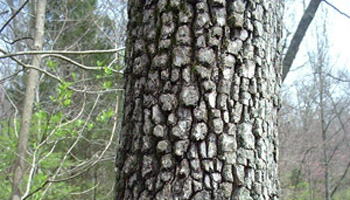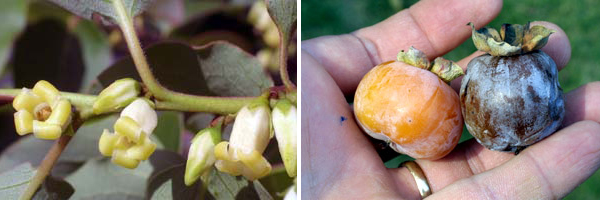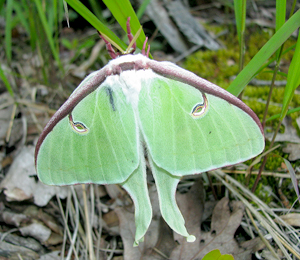Native Plant Profile: Persimmon

Persimmon bark; photo by Steven J. Baskauf
Persimmon (Diospyros virginiana) is a high wildlife value tree in the persimmon family (Ebenaceae). The genus name, Diospyros, literally translates to “Fruit of the Gods,” but when unripe, the fruit can be quite distasteful! This large fruit tree can grow up to 80 feet in height and prefers partial to full shade environments. It grows best in well drained soils, but can also persist in dry or moist soils, as well as within sterile soil environments. Persimmons can be found throughout much of Maryland, aside from Garrett County.
Persimmon has simple, alternate leaves that are four to six inches long and are oval in appearance. The leaves are thick and dark green above and pale on the underside. In autumn, the leaves sometimes turn orange or scarlet in color. The bark is distinct. It is dark brown or grey in color and is divided into scaly plates.
In May and June, persimmon trees flower. The tubular flowers are yellow or creamy white in appearance. Most persimmon trees have either male or female flowers. Therefore, both a male and female tree are needed to set fruit. Persimmon pollinators include honeybees, bumblebees, little carpenter bees (Ceratina spp.), digger bees (Anthophora spp., Synhalonia spp.), mason bees (Osmia spp.), leaf-cutting bees (Megachile spp.) and cuckoo bees (Nomada spp.).
The fruit is a rounded berry that ripens in mid-late fall. When mature, the fruit is yellow to orange in color with a waxy, pale outer coating. The edible fruits are sought after by humans and animals alike. One note of caution: while orange persimmons on a tree may look ripe, if they do not come off the tree with a slight tug, fall off on their own or undergo a freeze then they generally are not edible to people. Unripe persimmons are very astringent and, to quote Ralph Wiggum from the Simpsons, “It tastes like burning.” I personally can vouch for the terribly tart and puckering sensation caused by biting into an unripe persimmon!

Left: Persimmon flower, right: Persimmon fruit; photos by Steven J. Baskauf
Persimmons are sometimes planted due to their hardy nature, but occasionally they can be hard to find. More than 45 butterfly and moth species, including the Luna moth, lay their eggs on persimmon trees. Species like bear, deer, coyote, fox, raccoon, opossum, quail, squirrel, wild turkey and others have been known to consume the fruit.

Luna moth; photo by Kerry Wixted
Sources: Illinois Wildflowers | United States Department of Agriculture, Forest Service
Author’s Note
Sincerely,
Kerry Wixted
Also in This Issue:
Backyard Wildlife Fun: Tracks!
Citizen Science: Bats, Butterflies and Moths
Fall Seed Sowing
Fueling Fall Pollinators
Native Plant Profile: Persimmon
Native Wildlife: Virginia Opossum
Want HabiChat delivered right to your inbox? Click here to sign up!


 1-888-373-7888
1-888-373-7888 233733
233733